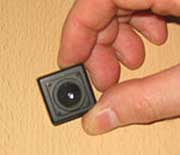Experts from the Bauman Moscow State Technical University have announced the development of a remarkable device capable of detecting hidden cameras.
 |
| No more worries about hidden cameras (Photo: CAND) |
The Russian Prosecutor General’s Office was the first to show interest in this technological achievement, as their former chief, Mr. Skuratov, became a victim of hidden camera footage while joking around with a few women in a sauna, leading to his humiliating resignation.
The idea of creating a hidden camera detector arose immediately after the scandal involving Mr. Skuratov. Although the footage that tarnished this Russian official’s reputation may not have been real, it underscored the principle that such surreptitious recording could indeed occur. Researchers decided to develop a device to prevent the proliferation of such intrusions, as they believe everyone has the right to a private life. Only science can protect that legitimate right.
The head of the research team, Professor Valeri Karasik, explained that they initially designed a device to detect the optical sights of sniper rifles. In any scope, there is a specific plate at the focal point of the lens, such as a photo sensor. When a laser beam, invisible to the naked eye, is directed at it, a light reflection effect occurs. The point where the rifle’s scope is aimed will flash like a bright spot on the detector’s screen.
On the surface, the device resembles a digital camera. It was tested in a laboratory set for an important meeting, where three hidden cameras had been secretly placed. The device’s task was to check and detect all walls, cabinets, and ceilings for potential hiding spots for secret “windows,” which can be as small as a millimeter, in the most unexpected places, such as in a person’s tie, in chandeliers, or in vases.
The device quickly identified one of the three hidden cameras. The scientists had concealed it inside a chocolate box. The “camera” laser immediately pinpointed a small breach in the box – a bright spot flashed on the detector screen. Surveillance was conducted right from that point! Fifteen minutes later, the second camera was also detected – it was hidden among the devices on the table. However, the third “invisible eye” remained elusive. The laser was aimed directly at the speaker (the camera might have been hidden in his tie), but it was still undetectable. It was only when a female staff member unexpectedly entered the laboratory and seemed to inadvertently fall within the lens’s line of sight that a blinking bright spot appeared on the detector screen. The hidden camera was concealed within a button of the female staff member’s clothing.
Numerous representatives from various special agencies visited the impressive technology at Bauman University to place orders. The Prosecutor’s Office of Russia showed enthusiastic support. The Moscow government was also interested in this invention, with the city’s Science and Technology Committee allocating funds for prototype development.
Initially, construction officials hoped to produce a series of products for hotels in the future, but protective agencies vehemently opposed this, as they themselves maintain a considerable number of “bugs” and hidden cameras. Only law enforcement agencies and owners of private villas truly showed interest in the new product.
Hoàng Thương


















































